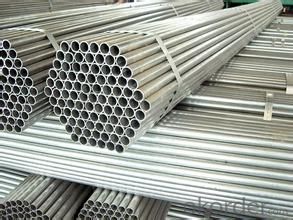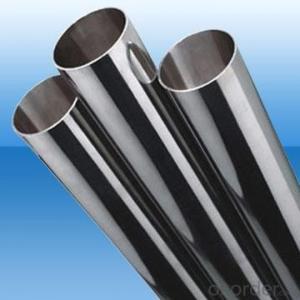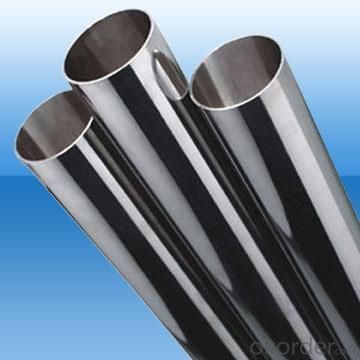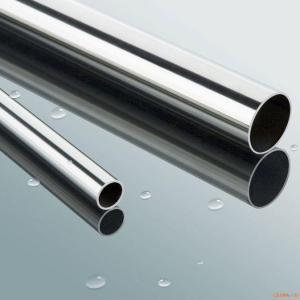Non-secondary API Stainless Steel Pipe Made in China
- Loading Port:
- Tianjin
- Payment Terms:
- TT OR LC
- Min Order Qty:
- 25 m.t.
- Supply Capability:
- 5000 m.t./month
OKorder Service Pledge
OKorder Financial Service
You Might Also Like
Specification
Non-secondary API Stainless Steel Pipe Made in China
1.Structure of Stainless Steel Pipe :
Seamless pipe is formed by drawing a solid billet over a piercing rod to create the hollow shell. As the manufacturing process does not include any welding, seamless pipes are perceived to be stronger and more reliable. Historically seamless pipe was regarded as withstanding pressure better than other types, and was often more easily available than welded pipe.
2.Main Features of the Stainless Steel Pipe :
• High manufacturing accuracy
• High strength
• Small inertia resistance
• Strong heat dissipation ability
• Good visual effect
• Reasonable price
3.Stainless Steel Pipe Specification:
Standard | GB, DIN, ASTM ASTM A106-2006, ASTM A53-2007 |
Grade | 10#-45#, 16Mn 10#, 20#, 45#, 16Mn |
Thickness | 8 - 33 mm |
Section Shape | Round |
Outer Diameter | 133 - 219 mm |
Place of Origin | Shandong, China (Mainland) |
Secondary Or Not | Non-secondary |
Application | Hydraulic Pipe |
Technique | Cold Drawn |
Certification | API |
Surface Treatment | factory state or painted black |
Special Pipe | API Pipe |
Alloy Or Not | Non-alloy |
Length | 5-12M |
Outer Diameter | 21.3-610mm |
Grade | 20#, 45#, Q345, API J55, API K55, API L80, API N80, API P110, A53B |
Standard | ASME, ASTM |
1) Material:20#(ASTM A 106/A53 GRB.API5LGRB,GB),45#,16Mn,10#.
2) Specification range:OD:21.3-610mm,WT:6-70mm,length:6-12m or according to the requirement of clients.
3) Excutive standards:GB,ASME API5L.ASTM A 106/A53,Despite of the above standards,we can also supply seamless steel pipe with standard of DIN,JIS,and so on,and also develop new products according to the requirements of our clients!
4) Surface:black lacquered,varnish coating or galvanized.
5) Ends:Beveled or square cut,plastic capped,painted.
6) Packing:bundles wrapped with strong steel strip,seaworthy packing.
4. Packing and Delivery:
Packaging Details: | seaworthy package,bundles wrapped with strong steel strip |
Delivery Detail: | 50-60days after received 30%TT or Original LC |
5. FAQ of Stainless Steel Pipe
A. How is the quality of your products?
Our products are manufactured strictly according to national and internaional standard, and we take a test on every pipe before delivered out. If you want see our quality certifications and all kinds of testing report, please just ask us for it.
Guaranteed: If products’ quality don’t accord to discription as we give or the promise before you place order, we promise 100% refund.
B. How about price?
Yes, we are factory and be able to give you lowest price below market one, and we have a policy that “ for saving time and absolutely honest business attitude, we quote as lowest as possible for any customer, and discount can be given according to quantity”,if you like bargain and factory price is not low enough as you think, just don’t waste your time.Please trust the quotation we would give you, it is professional one.
C. Why should you chose us?
Chose happens because of quality, then price, We can give you both.Additionally, we can also offer professional products inquiry, products knowledge train(for agents), smooth goods delivery, exellent customer solution proposals.Our service formula: good quality+good price+good service=customer’s trust
SGS test is available, customer inspection before shipping is welcome, third party inspection is no problem.
Any question, pls feel free to contact us !
6.Stainless Steel Pipe Images:


7. Company Information:
CNBM International Corporation (CNBM International) is the most important trading platform of CNBM Group Corporation, a state-owned company under the direct supervision of State-owned Assets Supervision and Administration Commission of the State Council.

- Q: What factory uses industrial stainless steel tube to be more?
- The electric power industry including nuclear power industry, the demand for stainless steel tube is large, the industry mainly uses the stainless steel seamless pipe, specific application fields: boiler pipes, water pipes, power tubes etc..According to the World Nuclear Association reports, China has 5 power stations under construction, 6 included in the plan, 19 are planning, it is estimated that power plant construction and maintenance of various types of stainless steel pipes each year about 25600 tons.
- Q: Can stainless steel pipes be used in the aerospace industry?
- Yes, stainless steel pipes can be used in the aerospace industry. Stainless steel is known for its high strength, corrosion resistance, and durability, making it suitable for various applications in aerospace such as fuel systems, hydraulic systems, and exhaust systems. Its ability to withstand extreme temperatures and pressure fluctuations makes it an ideal choice for aerospace engineering. Additionally, stainless steel's lightweight nature contributes to fuel efficiency and enhances overall performance in the aerospace industry.
- Q: What is the difference between 304H and 304 stainless steel pipes?
- The carbon content is what sets 304H stainless steel pipes apart from 304. Although both grades belong to the 304 stainless steel alloy, 304H has a higher carbon content than 304. This increased carbon content gives 304H pipes the ability to withstand higher temperatures, as they possess better strength and resistance against sensitization. Conversely, 304 stainless steel pipes are better suited for general applications due to their good corrosion resistance and widespread use in various industries. Consequently, when deciding between 304H and 304 stainless steel pipes, it is important to consider the specific requirements of the application, including the operating temperature and the need for enhanced strength and resistance against sensitization.
- Q: What are the specifications for stainless steel pipes?
- The specifications for stainless steel pipes typically include the material grade, dimensions (such as outer diameter, wall thickness, and length), and specific standards or certifications they adhere to, such as ASTM, ASME, or EN. Additionally, specifications may also include information about the surface finish, type of joint or connection, and any special requirements for corrosion resistance or mechanical properties.
- Q: Can stainless steel pipes be used for refrigeration systems?
- Indeed, refrigeration systems can utilize stainless steel pipes. Stainless steel, being an exceedingly robust material, exhibits exceptional resistance against corrosion, rendering it perfectly suitable for deployment in refrigeration systems where both moisture and low temperatures are prevalent. Moreover, stainless steel pipes boast remarkable thermal conductivity, facilitating efficient and effective heat transfer throughout the entire system. Furthermore, stainless steel pipes are effortlessly cleanable and maintainable, while also demonstrating the capacity to withstand significant pressure, thereby making them highly appropriate for deployment in refrigeration systems necessitating unwavering and enduring performance.
- Q: Do stainless steel pipes require any special coatings?
- Stainless steel pipes, being resistant to corrosion and staining, are highly durable and long-lasting. Their inherent corrosion resistance eliminates the need for extra coatings or treatments. The presence of chromium in the alloy composition creates a protective oxide layer on the surface, preventing rust and corrosion. As a result, stainless steel pipes can be used in various applications without the necessity of special coatings for protection.
- Q: Are stainless steel pipes suitable for automotive applications?
- Yes, stainless steel pipes are highly suitable for automotive applications. They are known for their excellent corrosion resistance, high strength, and durability, making them ideal for withstanding the harsh conditions of automotive environments. Additionally, stainless steel pipes offer good heat resistance, which is crucial in automotive exhaust systems. They are widely used in various automotive components such as exhaust systems, fuel lines, brake lines, and cooling systems.
- Q: What is the difference between double random length and single random length stainless steel pipes?
- Double random length stainless steel pipes differ from single random length stainless steel pipes in their dimensions and lengths. Double random length pipes are cut in random lengths that are twice the size of single random length pipes. In contrast, single random length pipes are cut in random lengths without any specific multiple. The purpose of utilizing double random length pipes is to accommodate longer sections of piping in industries that necessitate extended lengths. These pipes are typically employed in applications involving high pressure or temperature, such as oil and gas pipelines or petrochemical plants. On the other hand, single random length pipes are more frequently utilized for general-purpose applications where shorter lengths suffice. They are commonly used in plumbing, HVAC systems, or smaller industrial settings. To summarize, the primary distinction between double random length and single random length stainless steel pipes lies in their length. Double random length pipes are twice as long as single random length pipes and are employed in industries requiring lengthier sections of piping, while single random length pipes are more commonly used for general-purpose applications.
- Q: How do you calculate the pipe volume for a specific application?
- To calculate the pipe volume for a specific application, you need to multiply the cross-sectional area of the pipe by its length. The cross-sectional area can be determined by using the formula for the area of a circle (πr^2), where r is the radius of the pipe. Once you have the cross-sectional area, multiply it by the length of the pipe, and you will have the volume.
- Q: Can stainless steel pipes be used in the petrochemical industry?
- Yes, stainless steel pipes can be used in the petrochemical industry. Stainless steel is highly resistant to corrosion and can withstand high temperatures, making it an ideal choice for transporting and storing various petrochemical products. Its durability and strength also make it suitable for handling the high-pressure conditions often encountered in the petrochemical industry. Additionally, stainless steel pipes are easy to clean and maintain, ensuring the purity and integrity of the petrochemical products being transported. Therefore, stainless steel pipes are commonly used in petrochemical plants, refineries, and other facilities within the industry.
Send your message to us
Non-secondary API Stainless Steel Pipe Made in China
- Loading Port:
- Tianjin
- Payment Terms:
- TT OR LC
- Min Order Qty:
- 25 m.t.
- Supply Capability:
- 5000 m.t./month
OKorder Service Pledge
OKorder Financial Service
Similar products
Hot products
Hot Searches
Related keywords

























